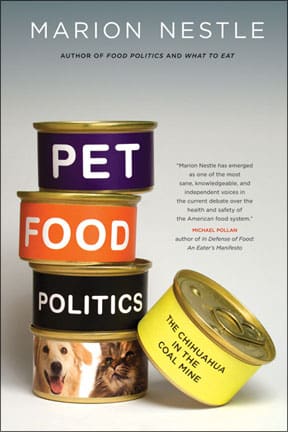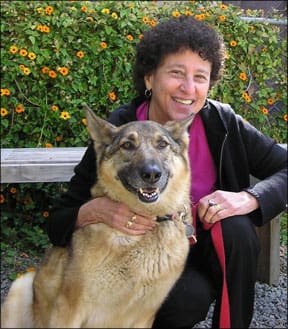Were you one of the millions of concerned dog owners who struggled to follow and make sense of the pet food recalls last year? If so (and what dog owner wasn’t), I predict that you’ll find Pet Food Politics: The Chihuahua in the Coal Mine to be the most riveting book you’ll read this year. Just released by the University of California Press, Pet Food Politics provides an in-depth look at the record-setting (and not in a good way) pet food recalls in 2007.
Pet Food Politics is authored by Marion Nestle, PhD, an expert in human nutrition and the food industry. Dr. Nestle (rhymes with pestle, not like the chocolate company) is the Paulette Goddard Professor in Nutrition, Food Studies and Public Health (an endowed professorship) at New York University, where she was the department chair from 1988 to 2003.
Nestle also holds appointments as Professor of Sociology in NYU’s College of Arts and Sciences and as a Visiting Professor of Nutritional Sciences in the College of Agriculture at Cornell University. Her degrees include a PhD in molecular biology and an MPH in public health nutrition, both from the University of California, Berkeley.

288
Dr. Nestle’s credentials in the human food industry transcend academia. She has served as senior nutrition policy advisor in the Department of Health and Human Services and as a member of the FDA Food Advisory Committee and Science Board. In 2004, she was awarded the American Public Health Association’s David P. Rall Award for Advocacy in Public Health for her work to shed light on the impact food and nutrition policies have on the nation’s health.
She is also author of a number of highly acclaimed books on food and the food industry, including Food Politics: How the Food Industry Influences Nutrition and Health (2002, second edition 2007, both from University of California Press); Safe Food: Bacteria, Biotechnology, and Bioterrorism (2003, University of California Press); and What to Eat: An Aisle-by-Aisle Guide to Savvy Food Choices and Good Eating (2006, North Point Press).
Why is this sort of human food expert poking her nose into pet food?
Dr. Nestle says that she was aware that she skipped past the pet food section of the grocery store, so to speak, when she wrote What to Eat, which was otherwise (as the subtitle describes) an aisle-by aisle guide to making food choices in supermarkets. Given that her life partner, Malden Nesheim, PhD, is a retired expert in human and animal nutrition, that omission must have been glaring.
With her work on What to Eat completed, Dr. Nestle cooked up the idea of doing a dog and cat version of the book with Dr. Nesheim. In February 2007, they signed a contract to co-author What Pets Eat for Harcourt – to the puzzlement and dismay, Nestle says, of many of their colleagues in human nutrition; why on earth would they bother with pet nutrition? Who cares?
When the pet food recall starting hitting the headlines the following month, their colleagues’ disapproval melted into wonderment at the couple’s prescience. Because, as it turns out, just about everyone with a dog or cat cares about dog and cat food – especially when some of it turns out to be deadly.
Dr. Nesheim and Dr. Nestle outlined the topics that they wanted to cover in What Pets Eat and divided up the research and writing work. One of Dr. Nestle’s responsibilities was a small appendix, envisioned as 10 or so pages that would appear in the back of the book, discussing the recalls of spring 2007. Her research about the pet food disaster grew in complexity and scope, along with her fascination for the story. Eventually the topic expanded into a chapter, and then took on a life of its own.
The result is Pet Food Politics, a separate book that actually got finished in advance of What Pets Eat – largely due to Dr. Nestle’s insatiable appetite for more information about the dramatic event. “Every question I had led to more questions,” she laughs. “And none of my experience with human food recalls prepared me for how this recall was handled – by the companies involved, government regulators, the media, and the public.”
Genesis of the book
I first met Drs. Nestle and Nesheim at Global Pet Expo – the world’s largest annual pet industry trade show – in February 2008. They were still deep into the research for What Pets Eat (which is due out from Harcourt late in 2009). I can’t tell you how much I enjoyed witnessing their immediate response to their first (and very overwhelming) experience with a pet industry trade show.
Held in San Diego’s enormous convention center, the 2008 installment of Global Pet featured almost 800 vendors, in more than 230,000 square feet of exhibitor space. The couple was fascinated, exhausted, and incredulous at the size and scope of the industry. We compared notes about the companies that were promoting pet food, treats, and chews, and as they shared their observations with me, I began to get a sense that their upcoming books were going to be quite revelatory.
This summer, I was thrilled to receive an advance copy of Pet Food Politics from its publisher, the University of California Press. A publicist for the book asked me if I would read it and perhaps contribute a blurb for its cover. After reading the first chapter, I sent Dr. Nestle an e-mail asking when I could schedule an interview with her to promote the book, because it is great.
Pet Food Politics not only delivers the most complete account of the 2007 wheat gluten/Menu Foods/Chinese ingredient recalls that pet owners will ever get, but also provides critical background information about each of the involved parties and the industry as a whole.
Dr. Nestle presents a detailed timeline of events – including all of the developments we read about in the newspapers, and many that we didn’t – and then analyzes the response of each of the players at each juncture. If you still have questions about the recall, you’re sure to find the answers in Pet Food Politics. And, if the title hasn’t already tipped you off, the book provides a fascinating look at the wider context of the tragic event. All the potential disadvantages and dangers of a globalized food supply were highlighted during the event.
Interview with Marion Nestle
I spoke with Dr. Nestle just before the publication of Pet Food Politics.
Nancy Kerns, Whole Dog Journal: Hello, Dr. Nestle. The first thing I want to say is thanks so much for writing this book! It’s a fascinating read, and full of new information, even for someone who really followed the story at the time. What sparked your interest in the recall?
Marion Nestle: Pet Food Politics was meant to be an appendix to What Pets Eat, a bigger book about the entire pet food industry that Mal Nesheim and I are writing. I was going to write a 10-page summary of the events around the recalls – and then I got caught up in it; it’s such a fascinating story and I could not believe how difficult it was to figure out what on earth was going on.
I was late getting to the story. When the recall happened, I was on a book tour for the paperback edition of What to Eat, and I couldn’t do the kind of tracking that I usually do when some food crisis happens that I’m really interested in. I was all over the country, and barely able to keep up with the travel, so most of what I knew about it was from USA Today. The USA Today reporters, by the way, did a fantastic job with the story.
When I finally sat down to work on what I thought would be an appendix, it was July 2007; the first recall happened in March. Our research assistant had prepared a timeline of the events for someone else, and I asked her for her sources, because it didn’t make sense in a lot of ways. One of the questions I had right away was, “Why did it take Menu Foods so long to issue the recall?” I was so curious about that; it seemed to me a rather long wait, and I couldn’t understand why.

Photo by Larry Cohen
288
In trying to sort out the timeline, I went to the PetConnection.com blog about the recall, starting from the most recent posts and working my way back. I spent several days doing that, just reading the day-to-day posts on the events. I couldn’t believe how much information they had there – newspaper clippings, FDA hearings, other blog posts – just an amazing accomplishment.
Whole Dog Journal: You must have felt like you fell down a rabbit hole . . .
MN: Yes and no. The fact of a food recall is one thing. But there were so many holes in the story that was publicly available! The story of melamine, for example. From the press accounts, it seemed as if no one could possibly imagine what melamine might be doing in pet food – or whether it could be responsible for the effects in dogs and cats that had been seen.
Whole Dog Journal: How were you were able to come up with so much information about melamine and cyanuric acid?
MN: I was able to write about the toxicity and use of melamine and cyanuric acid, thanks to my ability to read – and I’m being only a little sarcastic.
One of the things I came across on the PetConnection blog was an abstract from the Journal of the American Veterinary Medical Association (JAVMA), referring to a study on melamine that had been done in the 1960s. I’m trained in research, and one of the first things you learn when you do research is never to believe what you read in an abstract of a study, or, for that matter, anyone else’s account of what’s in a paper; you have to read the whole thing yourself. I found the study in the Cornell veterinary medical library; it was about deliberately feeding melamine to sheep and finding out that high doses formed crystals that blocked their kidneys.
Whole Dog Journal: One of the first things Dr. Nesheim said to me when I met you two was that he had access to these amazing research tools that hardly anyone uses: books. In today’s world, everyone looks to the Internet, and if what they are looking for is not there, they assume it doesn’t exist.
MN: In this case, the Internet had the abstract, but the abstract didn’t say why they did the study, and the reason they did the study was absolutely crucial. We read the study, and then all the ones in the references, just like they teach you to do in grad school.
The 1960s investigators knew that melamine contains nitrogen, and they wanted to find out if ruminant animals like sheep could use melamine nitrogen to make protein. That would have been a legitimate use if it had worked, but it killed the sheep. But melamine is a lot cheaper than protein, which is why it was used fraudulently by the Chinese wheat gluten manufacturers.
What was amazing about that old research was that the toxicity of melamine was so well worked out by the 1960s. There were incidents of melamine-contaminated feed – fish food – in the 1970s and 1980s. But nobody was talking about any of this. The FDA commissioned a big toxicology review that didn’t cite those old papers.
We submitted the findings of our literature review as a letter to the editor of JAVMA – as an academic exercise, really. One of our Cornell colleagues took us to task over this. He wrote us a “disappointed” letter saying that the old studies didn’t mean anything, that veterinarians were thoroughly aware of the studies; they just didn’t think they were relevant. Well, Mal and I thought they were relevant. The amounts of melamine that killed sheep in the 1960s weren’t all that different from the amounts in the recalled pet foods.
Whole Dog Journal: From the perspective of an average consumer, the initial message that Menu Foods and the FDA put out seemed to be that we were dealing with “contamination” . . . not fraud. The recall was announced on March 16. According to your timeline, it wasn’t until April 6 that the FDA mentioned the possibility that melamine could be a “deliberate adulterant.”
MN: Mal is an animal nutritionist. As soon as we heard that melamine was in the foods, we looked up its structure and saw how much nitrogen it contained. He knew right away that it must have been put there deliberately. Part of it was because he’s of a certain age; we’re really old! (Laughs). He remembers the old days when animal feed was routinely adulterated.
Whole Dog Journal: I have to admit, it makes me angry and frustrated to learn that any animal nutritionists “of a certain age” would immediately understand the potential significance of melamine “contamination” – and yet, no pet food industry people would suggest fraud as a possibility; the industry really closed ranks neatly on that possibility. It wasn’t until the New York Times article – “Filler in Animal Feed Is an Open Secret in China” – came out on April 30 that this was openly discussed.
MN: I’m with you. But perhaps I’m more suspicious than most. I wrote a book about the human food industry, called Food Politics, where I looked at how food corporations influence food choices. They don’t just advertise. They also lobby federal agencies and Congress, and do everything they can to convince food and nutrition professionals never to suggest that people would be healthier if they didn’t eat so much.

288
Whole Dog Journal: Given your experience with human food companies and government, was the response to this recall different from what you would have expected if something similar had happened to a human food company?
MN: Yes! First, the FDA didn’t really get involved in this in a serious way until they thought there was a potential threat to the human food supply. My initial impression from both government and industry was that they viewed the problem as “just pets.” The pet food companies should have known better. I can’t think of anything more inflammatory to anyone who owns a dog or cat than the expression “just pets.”
The FDA eventually realized that if melamine was in pet food, it could also be in the human food supply. And then, of course, it was. Who knew that surplus pet food was fed to pigs and chickens, or that wheat gluten is in fish food. That was one of the many surprises. The others? One company made more than 100 brands of pet food, from the cheapest to the most expensive. Pet food companies had no idea where their ingredients came from. Lots of the ingredients came from China. And nobody was minding the store.
Whole Dog Journal: Not to brag, but Whole Dog Journal’s readers knew about co-packers. Although the size of that particular co-packer was a surprise even to me.
MN: The scale! One of the things I have in this book is a list of the brands that were involved – not even all the lines made by each brand, just the list of brands – it’s a very long list.
Whole Dog Journal: In terms of the companies involved: What would you have expected if this sort of thing had happened to a human food company?
MN: Forgive me, but some of the companies that were involved are human food companies! We’re talking about Procter & Gamble here! [Editor’s note: Procter & Gamble makes Iams and Eukanuba, which were among the brands of foods that were recalled.]
These companies know exactly what they are supposed to do! They’ve heard food safety experts talk. They know about recalls. You document everything, you immediately go public with everything that you’ve got, you take your licks, and you move on. And the quicker you come clean, the better it goes. This one dragged on forever. From March 16 to the end of May, notices about affected products were still dribbling in. What were people who needed to buy food for their pets supposed to do? And didn’t anyone care? It didn’t look like it to me.
Whole Dog Journal: So what sort of conclusions have you drawn about the pet food industry as a whole?
MN: They have a lot of growing up to do. They have to take what they are doing much more seriously. This is a $17 billion a year industry, soon to be a $20 billion a year industry. This is big.
But I think that the corporate giants see pet food as a relatively small money generator. The pet food divisions are extremely profitable, but they represent just a few percent of the companies’ total revenue. Our next book, What Pets Eat, discusses this issue much further. The level of profit for these pet food giants is hefty. The ingredients are relatively cheap; by-products are waste products and don’t cost much. The companies can package pet foods and market them in all the fancy ways they add value, and make a very nice profit on them.
The other conclusions have to do with the Chihuahua part – the early warning about deep problems with FDA regulation and food trade, especially with developing countries. We’ve already seen that with the recent heparin poisonings.
What I keep hoping is that some good will come of all of this. At the pet food meetings we went to this year, we heard company after company talking about how they were now paying more attention to what goes into the foods, how they are trying to source ingredients from places they can actually inspect, and how they are sourcing better ingredients. Maybe they are doing this because they learned a lesson, or maybe they are just reading the handwriting on the wall: sales are up on foods with no by-products and with sources identified, and lots of people are doing home cooking. That’s not so good for the pet food business, but it may be just terrific for pets.
Whole Dog Journal: Thanks for your time. We look forward to What Pets Eat next year!






